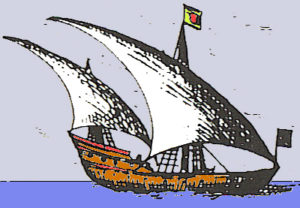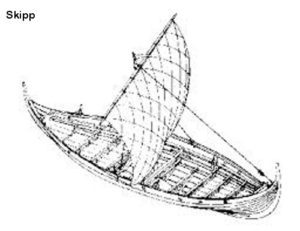Table of Contents
- Introduction
- Tusax (Shallow Water Merchant)
- Skipp (Short range cargo/ferry)
- Barge (Unrigged cargo/ferry)
- Waggler (Short range fishing craft)
Introduction
The vessels mentioned here are given as examples of waterborne transportation found on Valyr™. Keep in mind that the shipwright’s craft is still progressing and new innovations are always in demand. Even when the same type of ship is made by different shipwrights will likely have subtle differences in dimension, displacement and tonnage. Note that tonnage’ is the carrying capacity of the vessel and that displacement” is the amount of water displaced by a ship up to the waterline when at full capacity.
Tusax (Shallow Water Merchant)

Tusax class vessels are made for coastal merchant routes, large lakes, or for very wide rivers. Although they are intended to withstand heavy weather and large swells found far out at sea, sailors do not often take them beyond sight of land.
Also note that it’s relatively flat bottom enables it to sit on the sand or mud at low tide and allows loading and unloading
in areas without proper depth to accommodate deeper draft vessels. This is a disadvantage to it’s stability in deep water with heavy swells. A Tusax class ship may venture as far as 12-14 miles out from the shore.
A common configuration for a Tusax is a double masted, lateen rigged (triangle sail) ship with a center tail mounted rudder. The deck length is 65′ with a 22′ beam, 7 foot draft and a displacement of 75 tons. Cargo capacity is about 50 tons. Crew compliment is normally 26 people.
| (return to top) |
Skipp (Short range cargo/ferry)
 The Skipp class vessels are made for lakes and wide rivers or short jaunts out to sea. These vessels are not made to withstand heavy weather or large swells found far out at sea. Might go as far as 2-4 miles out from the shore.
The Skipp class vessels are made for lakes and wide rivers or short jaunts out to sea. These vessels are not made to withstand heavy weather or large swells found far out at sea. Might go as far as 2-4 miles out from the shore.
The typical configuration for a Skipp is a single masted square rigged (square sail) ship with a side mounted rudder. The deck length is 45′ with a 15′ beam, 5′ draft and a displacement of 45 tons. Cargo capacity is about 15 tons. Crew compliment is normally 9 people.
| (return to top) |
Barge (Unrigged cargo/ferry)
The shape of a barge is basically a deep shoe box lid. Rectangular with a flat bottom made for moving goods, people, and livestock, up or down a river, as a ferry at a river crossing or to cross a lake. These vessels are not made to withstand heavy weather nor are they meat for sea travel. Might go as far as 1 mile out from the shore.
The typical configuration for a barge has no sails, it’s human or animal towed with a rudder mounted at each end that can be hoisted up out of the water. The deck length is 45′ with a 12′ beam, 5′ draft and a displacement of 50 tons. Such vessels, can typically carry about 30 tons of cargo. Crew compliment is normally 5 people.
A smaller barge for use as a people and livestock ferry, is moved across a river or lake using human or animal power. It will usually have a rudder that can be moved to either end depending on which direction it’s moving across the water. These are usually much smaller that a cargo barge with a deck length of 15′ with a 10′ beam, 3′ draft and a displacement of 2 tons. Such vessels, can typically carry about 1 ton of cargo/people. Crew compliment is normally 1-2 people.
| (return to top) |
Waggler (Short range fishing craft)
A waggler is made for short trips on a lake, river or for coastal fishing. These are definitely fair weather vessels. As the name infers, they are not exceptionally stable craft. They are not made to withstand even medium weather or sea swells. Might go as far as 2 miles out from shore on a calm day.
A Waggler typical configuration has a pointed bow and stern with a starboard (right-side) mounted rudder, some variations have a simple single mast that is square rigged. The deck length is 28′ with a 9′ beam, 4′ draft and a displacement of 5 tons. Such vessels, can typically carry about 2 tons of cargo. Crew compliment is normally 2-4 people.
| (return to top) |
